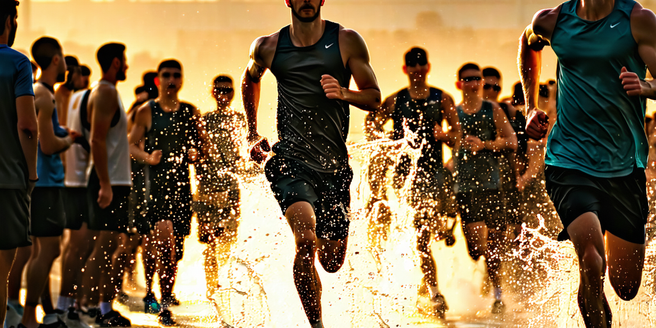
Understanding Heat-Related Illnesses
Heat-related illnesses occur when the body cannot effectively cool itself, leading to conditions like heat cramps, heat exhaustion, and heatstroke. Understanding these conditions is crucial, especially for athletes training in hot environments. Heat cramps are mild but can be an early sign of strain on the body. They usually occur after intense exercise and may be accompanied by spasms and pain. Heat exhaustion is more severe, characterized by heavy sweating, weakness, dizziness, and nausea. Without intervention, it can escalate to heatstroke, a life-threatening emergency marked by confusion, elevated body temperature, and possible unconsciousness. Recognizing the symptoms and taking preventive steps, like acclimating to the heat and staying hydrated, are essential to avoid these conditions.
Pre-Activity Hydration Strategies
Hydration is a vital component of athletic performance, especially in hot weather. It’s essential to begin activities well-hydrated to reduce the risk of heat-related illnesses. Athletes should consume water throughout the day, not just immediately before exercising. A general guideline is to drink about 500 ml of water or a sports drink two hours prior to the activity, allowing the body to absorb the fluid and clear any excess. During exercise, regular sips of water every 20 minutes can help maintain hydration levels. In hot conditions, consider sports drinks that provide electrolytes to replace those lost through sweat. Monitoring urine color can also be a simple way to gauge hydration status, with light yellow indicating proper hydration.
Clothing and Gear for Hot Weather
Choosing the right clothing and gear is essential for exercising in hot weather. Lightweight, loose-fitting garments made from breathable fabrics like cotton or moisture-wicking materials help keep the body cool. Avoid dark colors, as they absorb heat, and opt for lighter shades that reflect sunlight. A broad-brimmed hat and sunglasses can protect against the sun’s rays, while sunscreen is necessary to prevent skin damage. Proper footwear is also important; well-ventilated shoes that allow heat to escape can prevent overheating. Special cooling towels or vests are available and can be used to lower body temperature during breaks. In addition, gear such as hydration backpacks can ensure that athletes have easy access to fluids while on the move.
Recognizing Signs of Heat Exhaustion
Heat exhaustion is a serious condition that can occur during intense physical activity in hot weather. Recognizing its signs early can prevent progression to more severe heat illnesses. Common symptoms include heavy sweating, weakness, pale skin, rapid heartbeat, and dizziness. Nausea or vomiting, headache, and muscle cramps are also potential indicators. If these symptoms are present, it’s crucial to act quickly by stopping all activity, moving to a cooler place, and hydrating with water or a sports drink. Removing excess clothing and applying cool, wet towels to the skin can help lower the body temperature. If symptoms persist or worsen, seeking medical attention is vital. Awareness and preparedness can significantly impact an athlete’s safety when exercising in the heat.
Adjusting Workout Intensity and Duration
It’s important to adjust workout intensity and duration when exercising in hot weather to prevent heat-related illnesses. The body’s ability to manage heat is compromised when temperatures rise, increasing the risk of heat exhaustion or heatstroke. During peak heat hours, consider shifting workouts to early morning or late evening when it’s cooler. Reduce the intensity by slowing down pace or opting for shorter, more frequent sessions. Listening to your body and recognizing signs of overheating, such as excessive fatigue or dizziness, can indicate the need to decrease effort. Gradually acclimatizing to hotter conditions over several days can also help the body adapt. By taking these precautions, athletes can maintain their fitness regimen while safeguarding their health.
Post-Activity Cooling Techniques
After exercising in the heat, it’s crucial to cool down the body effectively to prevent lingering effects of heat stress. Start with a gradual cool-down to lower the heart rate, followed by hydrating with water or electrolyte-rich fluids to replace lost fluids. Using fans or air conditioning can help expedite the cooling process. A cold shower or a dip in a pool can effectively bring down the body’s temperature. Applying ice packs to areas with high blood flow, such as the neck, armpits, and groin, can further speed up cooling. It’s also beneficial to wear loose, breathable clothing. Taking these steps not only aids recovery but also prepares the body for future exercise sessions in hot conditions.
